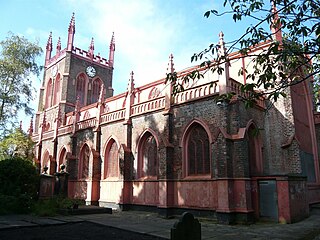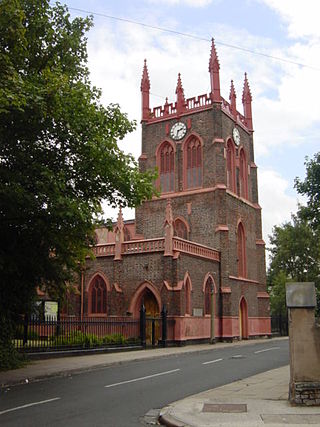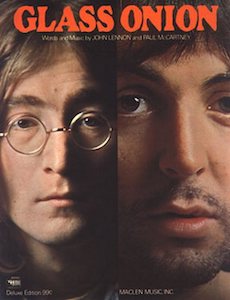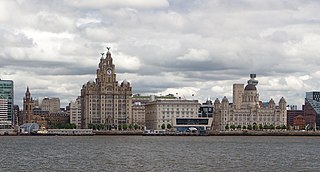
Liverpool is a cathedral city, port city, and metropolitan borough in Merseyside, England. It had a population of 496,770 in 2022. The city is located on the eastern side of the Mersey Estuary, adjacent to the Irish Sea, and is approximately 178 miles (286 km) northwest of London. Liverpool is the fifth largest city in the United Kingdom and the largest settlement in Merseyside. It is part of the Liverpool City Region, a combined authority with a population of over 1.5 million.

Merseyside is a ceremonial and metropolitan county in North West England. It borders Lancashire to the north, Greater Manchester to the east, Cheshire to the south, the Welsh county of Flintshire across the Dee Estuary to the southwest, and the Irish Sea to the west. The largest settlement is the city of Liverpool.

Sunderland is a port city in Tyne and Wear, England. It is a port at the mouth of the River Wear on the North Sea, approximately 10 miles (16 km) south-east of Newcastle upon Tyne. The built-up area had a population of 168,277 at the 2021 census, making it the second largest settlement in North East England after Newcastle. It is the administrative centre of the metropolitan borough of the same name.

Litherland is a town in the Metropolitan Borough of Sefton, Merseyside. Until 1899 it was within the historic county of Lancashire. It was an urban district, which included Seaforth and Ford. It neighbours Waterloo to the north, Seaforth to the west, and Bootle to the south and is approximately 5 miles (8.0 km) north of Liverpool city centre.

St Michael's Hamlet, also known as St Michael-in-the-Hamlet or simply St Michael's, is a suburb of Liverpool, Merseyside, England and a Liverpool City Council Ward. It is located to the south of the city, bordered by Dingle, Aigburth and Mossley Hill.

Waterloo is an area of the Metropolitan Borough of Sefton, in Merseyside, England. Along with Seaforth the two localities make up the Sefton Ward of Church. The area is bordered by Crosby to the north, Seaforth to the south, the Rimrose Valley country park to the east, and to the west the Crosby Beach and Crosby Coastal Park.

Toxteth is an inner-city area of Liverpool in the county of Merseyside.

Dingle is an inner city area of Liverpool, Merseyside, England. It is located to the south of the city, bordered by the adjoining districts of Toxteth and Aigburth. At the 2001 Census, the population was recorded at 13,246.

The Royal Albert Dock is a complex of dock buildings and warehouses in Liverpool, England. Designed by Jesse Hartley and Philip Hardwick, it was opened in 1846, and was the first structure in Britain to be built from cast iron, brick and stone, with no structural wood. As a result, it was the first non-combustible warehouse system in the world. It was known simply as the Albert Dock until 2018, when it was granted a royal charter and had the honorific "Royal" added to its name.

St George's Hall is a building on St George's Place, opposite Lime Street railway station in the centre of Liverpool, England. Opened in 1854, it is a Neoclassical building which contains concert halls and law courts, and is recorded in the National Heritage List for England as a designated Grade I listed building. On the east side of the hall, between it and the railway station, is St George's Plateau and on the west side are St John's Gardens. The hall is included in the William Brown Street conservation area.

St Luke's Church, more commonly known by locals as the bombed-out church, is a former Anglican parish church in Liverpool, England. It stands on the corner of Berry Street and Leece Street, at the top of Bold Street.

Wapping Dock is a dock on the River Mersey, England, and part of the Port of Liverpool. It is situated in the southern dock system, connected to Salthouse Dock to the north, Queen's Dock to the south. King's Dock was originally located to the west, but has since been filled in.

Garston is a district of Liverpool, England. Historically in Lancashire, it is bordered by the suburbs of Grassendale, Allerton, and Speke. It lies on the Eastern banks of the River Mersey.

St George's Church is in Everton, Liverpool, Merseyside, England. It is recorded in the National Heritage List for England as a designated Grade I listed building, and is the earliest of three churches in Liverpool built by John Cragg, who used many components in cast iron which were made at his Mersey Iron Foundry. It is an active Anglican parish church in the Diocese of Liverpool, the Liverpool archdeaconry, and the Liverpool North deanery.

St Michael's Church, also known as St Michael-in-the-Hamlet Church, is in St. Michael's Church Road, St Michael's Hamlet, Liverpool, Merseyside, England. It is recorded in the National Heritage List for England as a designated Grade I listed building. The church contains much cast iron in its structure, and its citation in the National Heritage List for England states it has "one of the earliest and most thorough uses of industrial materials in a major building". It is an active Anglican parish church in the diocese of Liverpool, the archdeaconry of Liverpool, and the deanery of Toxteth and Wavertree. Its benefice is united with those of Christ Church, Toxteth Park, and St Andrew, Liverpool.

The Church of Saint John the Baptist is an active Anglican parish church in the Diocese of Liverpool and lies in the archdeaconry of Liverpool and the deanery of West Derby. It is situated on the corner of West Derby Road and Green Lane, in Tuebrook, Liverpool, England. It was built in the 1860s to a design by GF Botley and is Grade I listed, as a building of exceptional architectural interest. The site also contains the Victorian vicarage and a mortuary house, also by Botley and both Grade II listed. It is also the site of the Brockman Memorial Hall, an early venue of the Beatles.

St Peter's Church is in Church Road, Woolton, Liverpool, Merseyside, England. It is an active Anglican parish church in the deanery of Liverpool South Childwall, the archdeaconry of Liverpool, and the diocese of Liverpool. The church is recorded in the National Heritage List for England as a designated Grade II* listed building. It is one of the largest parish churches in Liverpool, and its bell tower stands at the highest point of the city. The church also has connections with The Beatles.

"Glass Onion" is a song by the English rock band the Beatles from their 1968 double album The Beatles. The song was written by John Lennon and credited to Lennon–McCartney.

Liverpool Maritime Mercantile City is a former UNESCO designated World Heritage Site in Liverpool, England, that comprised six locations in the city centre including the Pier Head, Albert Dock and William Brown Street, and many of the city's most famous landmarks.
James Atherton was a British merchant and real estate developer known for his contributions to the economic and urban development of the Liverpool region in the late eighteenth and early nineteenth centuries. During this period, he was instrumental in transforming Everton into an affluent residential district and initiated the construction of the historically significant St George's Church. In association with his son-in-law William Rowson, he founded the seaside resort of New Brighton in 1830.



















